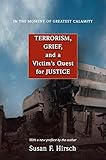In the Moment of Greatest Calamity : Terrorism, Grief, and a Victim's Quest for Justice - New Edition / Susan F. Hirsch.
Material type: TextPublisher: Princeton, NJ : Princeton University Press, [2021]Copyright date: ©2009Description: 1 online resource (264 p.) : 8 halftonesContent type:
TextPublisher: Princeton, NJ : Princeton University Press, [2021]Copyright date: ©2009Description: 1 online resource (264 p.) : 8 halftonesContent type: - 9781400828845
- SOCIAL SCIENCE / Anthropology / Cultural & Social
- Accountability Review Board
- Albright, Madeleine
- Baugh, David
- Bergman, Jeanne
- Borradori, Giovanna
- Clark, Ramsey
- Classified Information Procedures Act
- Cornell, Christine
- Derrida, Jacques
- East Africa
- Elshtain, Jean Bethke
- FBI agents
- Francisco, Gerard
- Freeh, Louis
- Geneva Convention
- Goldman, Laurence
- Hart-Rudman Commission
- Internal Revenue Service
- Islam
- Islamic law
- Kenya
- Kiswahili
- Layish, Aharon
- Minow, Martha
- Miranda rights
- Mombasa (Kenya)
- National Public Radio
- Oklahoma City bombing
- Pemba
- Rahman, Omar Abdul
- Rwanda
- Salameh, Mohammad
- Sufism
- Tuerkheimer, Frank
- anthropology
- death penalty
- defense attorneys
- edda, waiting period
- embassy bombings investigation
- faith
- funeral
- grief
- human rights
- justice
- legal systems
- matanga
- mourning
- mujaheddin
- perjury
- rituals
- sentencing
- terrorism
- tourism
- 967.8/232042 22
- online - DeGruyter
| Item type | Current library | Call number | URL | Status | Notes | Barcode | |
|---|---|---|---|---|---|---|---|
 eBook
eBook
|
Biblioteca "Angelicum" Pont. Univ. S.Tommaso d'Aquino Nuvola online | online - DeGruyter (Browse shelf(Opens below)) | Online access | Not for loan (Accesso limitato) | Accesso per gli utenti autorizzati / Access for authorized users | (dgr)9781400828845 |
Frontmatter -- Contents -- PREFACE TO THE PAPERBACK EDITION -- PREFACE -- Figure 1. Map of East Africa. Credit: Tad Slawecki -- INTRODUCTION -- CHAPTER 1 Becoming a Swahili Widow -- CHAPTER 2 Recognizing New Identities -- CHAPTER 3 Recounting Chaos -- CHAPTER 4 Exposing a Conspiracy -- CHAPTER 5 Proving a "Jihad Job" -- CHAPTER 6 A Victim's Burden -- CHAPTER 7 Dramatic Exposures -- CHAPTER 8 Representing the Defendant -- CONCLUSION -- ACKNOWLEDGMENTS -- NOTES -- GLOSSARY -- INDEX
restricted access online access with authorization star
http://purl.org/coar/access_right/c_16ec
On August 7, 1998, bombs exploded at two United States embassies in East Africa. American anthropologist Susan Hirsch and her husband Jamal, a Kenyan, were among the thousands of victims, and Jamal died. From there, Hirsch went on to face devastating grief with the help of friends and families on two continents, observing the mourning rituals of her husband's community to honor him. When the alleged bombers were captured and sent to New York to stand trial, she witnessed firsthand the attempts of America's criminal justice system to handle terrorism through the law.In the Moment of Greatest Calamity is her story--a tale told on many levels: personal, anthropological, legal, and, finally, political. The book's central chapters describe Hirsch's experience of the bombing trials in a Manhattan federal court in 2001, including a behind-the-scenes look at the investigation leading up to the trial, encounters with some of the FBI's leading terrorism investigators, and many moments of drama from the proceedings themselves. Hirsch reveals the inner conflict that results from her opposition to the death penalty and concludes that the trial was both flawed and indispensable. Hirsch's story of this tragedy and its legal aftermath comes to life through--and is enhanced by--her skills as a social scientist. Her unique viewpoint makes it unlike any other story about terrorism.
Mode of access: Internet via World Wide Web.
In English.
Description based on online resource; title from PDF title page (publisher's Web site, viewed 24. Aug 2021)


